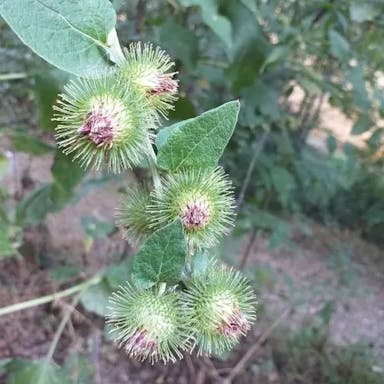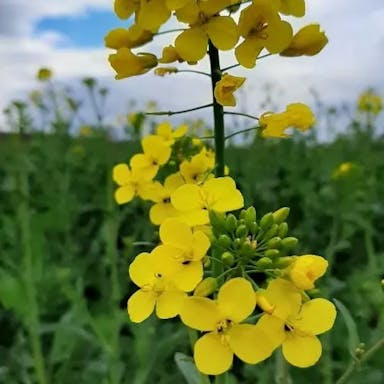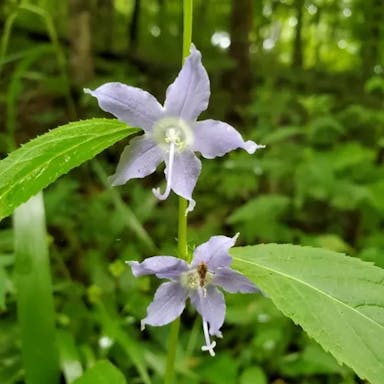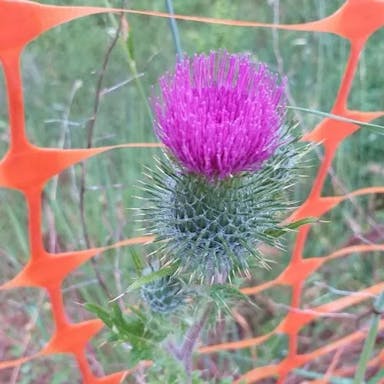The impressively tall Echium pininana, commonly named Giant viper's-bugloss, epitomizes the idea that good things come in large packages. This stately plant is native to the picturesque Canary Islands and can reach great heights, towering up to about three meters when fully grown. Its base sprouts a rosette of sizable lance-shaped leaves that progressively decrease in size as they snake up the elongated stem. Arranged in dense elongated clusters known as racemes are the plant's tubular-shaped flowers, which may be blue, purple, or somewhere in between, dependant on variety. The blossoms attract beneficial pollinators like bees and butterflies. Though it produces small nut-like fruits containing seeds, this biennial or short-lived perennial is mainly prized for its outsized ornamental value in the landscape. Echium pininana thrives best in a mild climate with well-drained soil and ample sunlight. Shelter from harsh winds helps prevent damage. Its vertical habits lend height and drama, making it a striking choice for the back of a flower border. While relatively simple to cultivate, a large mature specimen of Giant viper's-bugloss makes an unforgettable statement in the garden.
Giant viper's-bugloss
- Scientific name
- Echium pininana
Basic Information
- Boraginaceae Family Echium Genus Giant viper's-bugloss Species
- Boraginaceae > Echium > Echium pininana
- 83%
- The Completeness of This Encyclopedia
Please help us complete the encyclopedia, Terrarium is a encyclopedia service to be completed with everyone in the world. Currently, this page is 83% complete. For more information on how to contribute, please click here.
- Biennial
- Forb/herb
- Height
- 400cm ~
- Flower Color
- Leaf Color
- Anthesis
- spring, summer
- Sunlight Exposure
Full Sun Long hours of sunlight from morning to afternoon Partial Shade A location in the shade of a tree or where either the morning or afternoon is shaded Full Shade A place where there is no direct sunlight
- Full Sun
- Hardiness Zones
This is an indicator to know to which zone each plant can winter. Knowing the zone of each plant gives you an idea of the cold temperature resistance when grown in the ground without a roof. 2: -42.7 to -40.0 3: -39.9 to -34.4 4: -34.3 to -28.9 5: -28.8 to -23.3 6: -23.2 to -17.8 7: -17.7 to -12.2 8: -12.1 to -6.7 9: -6.6 to -1.1 10: -1.0 to 4.4 11: 4.5 to 10.0
- 9
- Cold resistance
- Fair
- Heat resistance
- Good
- Habitat of origin
- Canary Islands
- Growth Rate
- Fast
What is Giant viper's-bugloss (Echium pininana)?
What is Giant viper's-bugloss (Echium pininana)
Flower meaning
Giant viper's-bugloss, scientifically known as Echium pininana, does not have a specific flower language commonly used in America. However, in different cultures and time periods, certain flowers may carry different meanings. For example, in Victorian England, the language of flowers was highly popular, and each flower had a specific meaning assigned to it. These meanings may not apply to the American flower language. It is worth mentioning that birth flowers are a popular concept, where each month is associated with a specific flower. Giant viper's-bugloss is not commonly recognized as a birth flower for any month. To summarize, while Giant viper's-bugloss does not have a flower language in America, it is important to consider the cultural context when interpreting the language of flowers.
Calendar of Giant viper's-bugloss (Echium pininana)
Calendar
A common name of Echium pininana is Giant viper's-bugloss. It originally comes from the Canary Islands. It is grown for decoration in the United States. Its brilliant blue flowers bloom in summer from June to August. The flowers thrive in July. It blooms for several weeks. Spent flowers should be removed to lengthen the bloom time. Water and sunshine also help it flower longer.
How to grow Giant viper's-bugloss (Echium pininana)
Watering
The optimal timing and approach of watering for the Giant viper's-bugloss plant depends on various influences. Throughout the expansion season, which generally happens from spring to early fall, the plant needs frequent hydrating to keep up soil dampness. It is suggested to hydrate the plant profoundly once every seven days, guaranteeing that the water enters the root zone. The measure of water required can shift contingent upon the soil type and climate conditions, yet by and large, giving 1 inch (2.5 cm) of water every week is adequate. In difference, during the inactive season, which normally happens in late fall and winter, the plant requires less visit watering. It is vital to permit the soil to dry out between waterings to forestall root decay. Watering once at regular intervals is typically sufficient during this period. To decide the ideal watering recurrence and sum, it is basic to screen the soil dampness level normally. This should be possible by embedding a finger or a mugginess meter into the soil to evaluate its dampness content. Change the watering timetable as needs be to keep up with the soil sogginess at a proper level.
Soil and Fertilizer
Giant viper's-bugloss, scientifically known as Echium pininana, thrives in well-drained soil with a pH range of 6.0 to 7.5. For newly planted Giant viper's-bugloss, it is advisable to mix a slow-release granular fertilizer into the soil at planting time. During the growing season, apply a water-soluble fertilizer every 4 to 6 weeks. Avoid over-fertilization, as it can lead to excessive vegetative growth and reduced flowering. Regular soil testing is recommended to monitor the nutrient levels and pH of the soil. Adjust the pH if necessary using appropriate soil amendments. It prefers sandy or loamy soil that is rich in organic matter. The plant requires full sun exposure for optimal growth. To ensure healthy growth, it is recommended to apply a balanced fertilizer with an N-P-K ratio of 10-10-10 or 14-14-14. Fertilizer should be applied during the growing season, which typically starts in spring and lasts until early fall. Apply the fertilizer at a rate of 1 to 2 pounds per 100 square feet, ensuring it is evenly distributed. Dissolve the fertilizer in water according to the manufacturer's instructions and apply it around the base of the plant.
Sunlight and Place
Giant viper's-bugloss, a plant species with vibrant blue flowers, thrives in full sun exposure. It can withstand temperatures as low as -20°C (-4°F) and as high as 40°C (104°F). The plant needs ample water during summer to prevent dehydration. Well-drained soil with good air circulation is recommended. This helps prevent waterlogging and promotes healthy growth. Sunlight for at least 6 hours per day is required. This ensures photosynthesis and flower production. In summary, the hardy Giant viper's-bugloss tolerates varying temperatures. It needs full sun exposure and minimum 6 hours of sunlight daily for optimal growth and flowers. Proper placement and watering are key for its health.
Advanced Information of Giant viper's-bugloss (Echium pininana)
Pruning
Giant viper's-bugloss benefits from pruning, removing dead branches. Thinning helps shape, prevent overgrowth. Apply fertilizer after pruning. Water and mulch also help. Should prune and cut back every year for health.
Planting and Harvest
Giant viper's-bugloss, scientifically known as Echium pininana, is a plant that can be potted or planted in the ground. When caretaking with pot or ground planting, one must give proper sunlight, potting soil quality, water amount, and nutrient balance. Neglect leads to withering. Every few years, repotting in a bigger container refreshes limited root space. Adjust any distress with immediate remedy. Varied blooms bring enjoyment.
Propagation
Giant viper's-bugloss can be propagated through various methods such as sowing seed cells, dividing, cutting article, and slicing part that helps grows. For spread by placing seed cells, gather mature seed cells from the root and place them in well-draining land. Keep the land moist and provide adequate light for starting to grow. For dividing, carefully dig up the root and separate the clumps into smaller sections, making sure each section has roots attached. Replant the divisions in separate containers or directly in the ground, providing proper care and watering. To spread through cutting article, take stem cutting articles from healthy plants and remove the lower leaves. Dip the cut end in rooting hormone and plant it in a well-draining potting mix. Keep the land moist and provide indirect light until roots develop. Cutting part that helps grows can also be used for spread. Take healthy cutting part that helps grows and place them in a container with moist land. Make sure the cutting part that helps grows is partially buried and keep the land consistently moist. Roots will develop from the leaf base, and new plants will form. Harvesting can be done when the root has reached maturity and the desired parts, such as flowers or leaves, are ready for use. Harvesting should be done carefully to avoid damaging the root.
Pests and Diseases
Giant viper's-bugloss (Echium pininana) is susceptible to several pests and diseases. A common pest that affects this plant is the insect. These small insects feed on the sap, causing damage to the leaves and stems. To prevent infestations, regular monitoring of the plant is recommended, and if detected, they can be controlled using solutions or oils. Another pest that can affect Giant viper's-bugloss is the arachnid. These tiny arachnids feed on the plant's sap, causing yellowing and wilting of the leaves. To prevent infestations, maintaining proper plant hygiene by removing any infested leaves and regularly spraying the plant with water to increase humidity can be helpful. In terms of diseases, Giant viper's-bugloss can be susceptible to a fungal disease. This disease appears as a white coating on the leaves and stems. To prevent it, it is important to provide good air circulation around the plant and avoid overhead watering. Solutions can also be used to control the disease if necessary. Lastly, Giant viper's-bugloss can be susceptible to a condition caused by overwatering or poorly drained soil. This can cause the plant to wilt and eventually perish. To prevent it, it is important to ensure the plant is grown in well-draining soil and watered appropriately, allowing the soil to dry out between waterings. Overall, regular monitoring, proper plant hygiene, and providing optimal growing conditions can help prevent and control pests and diseases that may affect Giant viper's-bugloss.
Habitat of Giant viper's-bugloss (Echium pininana)
Habitat
Toxicity of Giant viper's-bugloss (Echium pininana)
Health Benefits
- edible
- Inedible
- Toxic
- toxic
NO DATA
Toxic for dogs and cats
NO DATA
Q&A of Giant viper's-bugloss (Echium pininana)
- Is there a recommended way to choose Giant viper's-bugloss?
Giant viper's-bugloss, scientifically known as Echium pininana, is a stunning plant that can add beauty to any garden. This variety is perfect for creating a dramatic focal point in the garden. Another variety to consider is 'Snow Tower', which produces white flowers and can also reach impressive heights. If you prefer a more compact option, 'Pink Fountain' is a great choice, with its pink flowers and shorter stature. When purchasing seeds or seedlings, make sure they are fresh and of good quality. Look for seeds that are plump and firm, and seedlings that have healthy foliage and strong stems. The Giant viper's-bugloss can add color to flower gardens with blue, pink or white blooms. Proper selection and care results in showy flowering spires. Check seedlings for health and vigor before planting.












